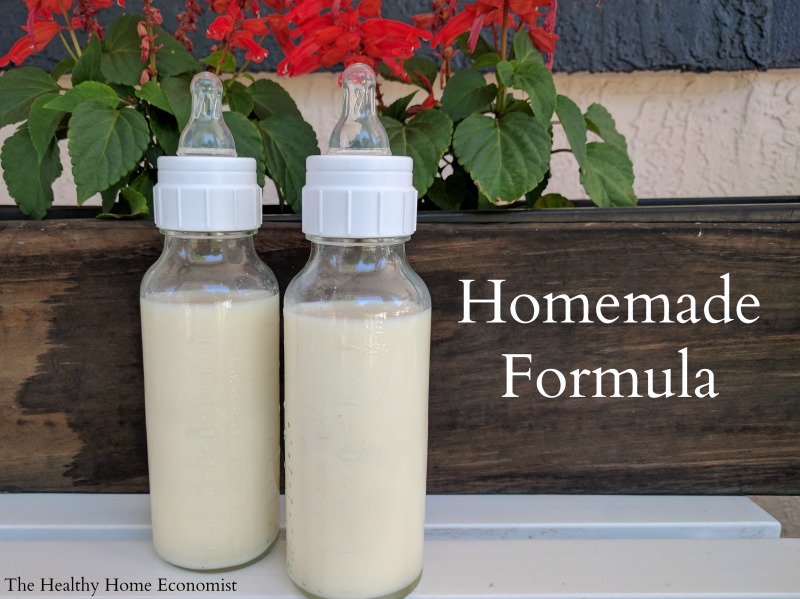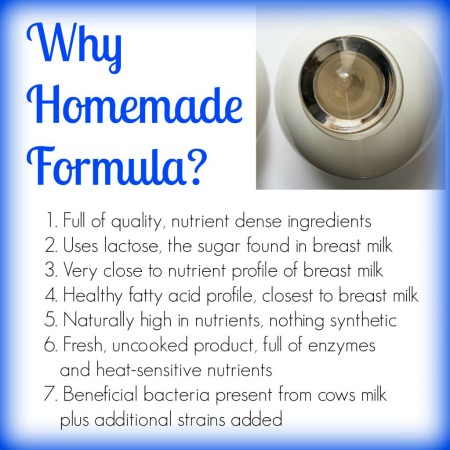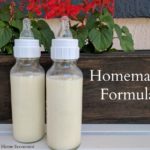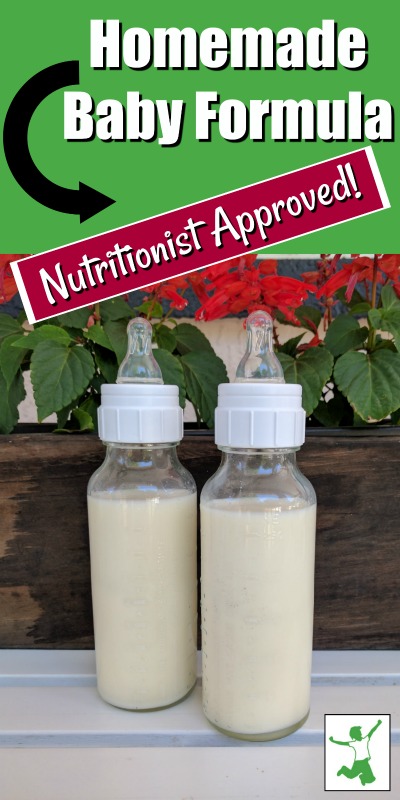Table of Contents[Hide][Show]
A nourishing homemade baby formula using safe, whole ingredients. This recipe was developed and tested by Dr. Mary Enig, a PhD Nutritionist and originally published in Nourishing Traditions cookbook in 1996. It was formulated to match breastmilk as closely as possible and is also suitable for infants. Source: Weston A. Price Foundation

There is no doubt that breastfeeding your baby is the best option for the child’s long-term health and development. Human breastmilk from a well-nourished mother is the perfect food for baby. However, in circumstances where the child is adopted or the Mother finds herself unable to breastfeed, formula feeding becomes necessary. In those cases, homemade baby formula is best.
Using a baby formula recipe that closely matches the nutritional profile of breastmilk is a far better choice than even organic baby formula from the health food store. More on this below.
Note: Donor programs are widely available for human breastmilk. But, the diets of the donor mothers are unknown and most likely nutritionally insufficient. In addition, breastmilk banks pasteurize the donated breastmilk which destroys much of the nutritional benefit. Unless you are fortunate to have a trusted and direct donor milk source in your community, avoid this option!
Dangers of Commercial Formula
Commercial formulas are always a poor choice for a number of reasons. First of all, formula manufacturers line the cans with the chemical BPA. This substance disrupts hormone development and is a probable contributor to early puberty in girls, and ADHD, urogenital abnormalities, and other ills in boys.
The European Food Safety Authority found that canned commercial formula is a significant source of BPA for infants, exposing the child to 13mcg of BPA per kg of body weight per day! BPA-free formula cans are no better. The chemical BPS is typically used instead which is just as dangerous.
Beware that manufacturers pack even organic commercial formula like Earth’s Best in BPA cans. Worse, they use organic brown rice syrup as the primary sweetener which is known to be frequently contaminated with arsenic.
In addition, all commercial milk formulas are processed at extremely high temperatures which violently denature the fragile milk proteins, render them allergenic, and add carcinogens to the final product. Soy infant formula is the worst. Obscenely high processing temperatures not only denature the proteins but large levels of phytic acid in soy block mineral absorption by the infant. Moreover, soy-based plant estrogens disrupt the hormonal development of the baby!
It seems that for the concerned Mother who is unable to breastfeed, learning how to make baby formula at home with safe, pure ingredients is the most prudent way to go!
Why Make Homemade Formula Even if You Are Breastfeeding
In the video below, I show you how to make your own safe, healthy raw milk homemade formula for your baby.
The recipe I follow was originally published in the cookbook Nourishing Traditions in 1996 and developed by Dr. Mary Enig.
Even though I breastfed each of my children for at least 2 years, I made this exact formula for my own children when I was away for the day or the evening as pumping was not an option that worked well for me.
I even used this homemade formula for an entire day once when I had some dental work done and was advised to pump and discard for 24 hours.
As a result, even successfully breastfeeding Moms can use this wonderful homemade formula as a supplement when necessary to their own nutrient-dense breastmilk!
It is advised that even breastfeeding Mothers have the ingredients for this formula on hand for an emergency. If Mom is sick or otherwise unable to nurse, Dad can step in and make this safe alternative until Mom is back on her feet. It takes a few days to a week to gather all the ingredients together to make this formula, which is why I advise having them on hand at all times.
Homemade Most Nutritious
The image below lists the reasons why it is worth it nutritionally to make formula yourself for your precious baby!
You can order all of the required ingredients for the homemade baby formula in one package from this reputable, vetted source.
Moms who have successfully used this formula feeding your children, please post about your experience in the comments section to encourage those who are considering it and need some Mom to Mom encouragement!

Where to Source Quality Milk
The most widely available grass-fed milk around the world is from cows. This is usually the most budget-friendly and easily sourced milk for this recipe for homemade formula.
If only goat milk is available in your area, this recipe for goat milk baby formula can be used instead. When using milk from ewes, please refer to the linked article for an adjusted recipe; one of the benefits of sheep milk is that it is higher in healthy fats than either goat or cow milk.
Camel milk formula is another option that is a particularly digestible form of dairy and growing in popularity around the world.
Alternatively, you can use low temp (vat) pasteurized, non-homogenized whole milk cultured with a piima or kefir starter. Then substitute the piima milk or kefir for the raw milk portion of the formula recipe. Cold-pressed raw milk also must be cultured before using it as it contains no probiotics.
Do NOT use ultrapasteurized (UHT) milk even if organic as it is too highly processed and extremely allergenic!
It is also best to avoid all types of powdered milk for this recipe. The factory process of making milk powder reduces nutrition considerably and denatures it, which makes it more likely baby will have an allergic reaction.
Dairy Allergy Option
If all types of dairy prove unsuitable for your baby, make this nondairy baby formula recipe instead. It uses a base of homemade bone broth as a substitute for milk. It is important not to utilize a plant-based or otherwise vegan baby formula recipe.
Avoid buying bone broth to make the dairy-free formula. Make it yourself! Manufacturers of commercial bone broth, even if authentic, may water down the end product. This is apparent if it does not gel when chilled in the refrigerator.
Many brands have toxic packaging issues as well. If you must buy it in a pinch, see my shopping guide page for vetted brands that are safe.

Homemade Baby Formula Recipe (for infants too)
A nourishing baby formula recipe you can make at home with safe, whole ingredients developed and tested by a PhD nutritionist to match breastmilk as closely as possible. Also suitable for infants.
Ingredients
- 2 cups raw cow milk OR organic whole milk yogurt
- 1 7/8 cups filtered water
- 1/4 cup liquid whey
- 4 Tbl lactose
- 1/4 tsp Bifidobacterium infantis powder
- 2-4 Tbl raw or pasteurized cream
- 1/2 tsp cod liver oil unflavored
- 1/4 tsp butter oil unflavored
- 1 tsp sunflower oil preferably organic
- 1 tsp extra virgin olive oil preferably organic
- 2 tsp virgin coconut oil preferably organic
- 2 tsp nutritional yeast
- 2 tsp gelatin
- 1/4 tsp acerola powder
Instructions
-
Fill a 2 cup Pyrex measuring cup with filtered water and remove 2 TBL (this will give you 1 7/8 cup water).
-
Pour about half the water into a pan and turn burner on medium.
-
Add the gelatin and lactose and let dissolve, stirring occasionally.
-
When gelatin and lactose are dissolved, remove pan from heat and add the rest of the water to cool.
-
Stir in the coconut oil and butter oil until melted.
-
Put remaining ingredients in a glass blender.
-
Add the water mixture and blend for about 3 seconds.
-
Place formula in glass baby bottles or a glass jar and refrigerate.
-
Before giving to baby, warm glass bottle in a pan of hot water or a bottle warmer. NEVER microwave baby bottles!
Recipe Video
Recipe Notes
If using raw cow milk from holstein cows, use 4 Tbl of extra cream (otherwise use 2 Tbl extra cream).
If choosing to make this homemade formula with camel milk, be sure to include 4 Tbl extra cream as camel milk is lower in cream than cow milk.
Do not use high oleic sunflower oil. Use only the brand recommended in the ingredients list which is cold pressed, organic, unrefined, and low oleic.
*Do NOT use powdered whey from the store as it is denatured. Avoid whey from making cheese as it will curdle the formula.
*Do not substitute pasteurized or powdered milk as these are heavily processed, denatured and allergenic foods.
*Do NOT use ultrapasteurized (UHT) cream. It is highly allergenic. Raw or pasteurized cream is acceptable.
*Do NOT use fish oil or krill oil instead of high vitamin cod liver oil as they do not contain any Vitamin D and very little to no Vitamin A.
Collagen powder may be substituted for the gelatin in a pinch (more on peptides in baby formula in this article).
If you are wondering where is the iron in homemade baby formula, this article provides an explanation.
If baby experiences constipation using this formula, try adding 1 tsp of molasses to each batch. This should help move things along.
How to Transition to DIY Formula
Once you’ve viewed the video, gathered the ingredients, and made your first batch, how do you feed it to your baby for the first time?
It is important not to switch all at once as this can cause gas, excessive spit-up, or an uncomfortable change in diaper habits such as constipation or overly loose stools.
Start by giving your baby three-quarters of the old formula blended with one-quarter of the homemade. Try this ratio for a day or two and see how your infant responds.
If no digestive upset or major change in diaper habits occurs, increase the amount to a 50-50 blend of old formula to homemade. Observe for another day or two as before.
If no major issues, increase once again to three-quarters homemade formula to one-quarter old formula. If baby does well on this blend for a third time, you are ready to fully transition to the homemade formula.
At any time during the transition, symptoms of intolerance emerge, back up to the previous successful blend ratio and stay there for a day or two before attempting to increase once again.
Homemade Formula FAQ
Weston Price Foundation
Feeding an Adopted Baby
Traveling Tips with Baby Formula Made at Home
Iron in Baby Formula
Collagen Peptides instead of Gelatin for Homemade Formula?










Hi! I have been using the bone broth liver based formula for my baby for about a month. He is almost 4 months right now. he is tolerating it very well except for his runny poops. I thought maybe after a week or two he would adjust to it but it seems to be the same. He poops about after every bottle and they are very runny and come shooting out almost every time. Should this be something that I be concerned about? Is there anything I can add that would help this change?
You can try leaving out the whey and see how it goes. You can also try using a different type of bone broth. For example, if you are using chicken broth, try beef or turkey instead. I also hope you are making your own bone broth. The commercial ones are almost without exception far too watery for baby formula purposes.
I just wanted to let you know I have been giving my baby girl this formula for over two months now, since she was almost ten months old. She is doing fantastic on it! Her patchy skin has almost completely gone away, and I noticed something else. Around the time she was 7 months old I started her on food. About every two weeks she would get sick for two or three days and not want to eat or have her bottles. Then she’d throw up for a day. The doctor thought it was a sensitivity to food in general. About 3 weeks after she was on this formula she quit having these episodes! It’s been two months now since the last one. I’m attributing it to this raw cow milk formula and the homemade bone broth I made for her to drink also.
Hi Sarah, I am looking to make this formula for my little one, but have a question I am hoping you might answer. He was born premature and I am supposed to have him on neosure 22 twice a day, the calorie per serving is 100. What changes can I make in your recipe to get it to the higher calorie content? I really don’t want to feed him any store bought formula as I don’t/won’t eat most of the ingredients myself.
Thank you
The calories provided in the nutritional information in the recipe are per ounce. I’m sure your baby would consume 4 ounces in one feeding, right? That would be 100 calories.
I had been giving my baby “Baby’s Only Organic” lacto relief formula since he was 2 weeks old because of a very low breast milk supply. He was handling it fairly well up until four months then he started to develop eczema on his cheeks, so I did some research and found this homemade formula recipe and since we already consumed raw milk as a family it didn’t seem all that much of a stretch to prepare this for my infant. He did wonderful for about a week. His eczema has improved by 75% and he even stopped spitting up completely. The only problem was his bowels became so hard. I looked up your recommendations for constipation and took out an additional 1/4 cup of water and added an additional 1/4 cup of whey and he did seem to have an easier time passing his stool these last few days (though they still appeared hard) However, today he had a bloody bowel, so I’m forced to put him back on the commercial formula until we figure out the problem. My assumption is that he’s intolerant to dairy. I will continue to offer him egg yolks and cod liver oil. I’d like to try the meat based formula, but honestly I’m a little freaked out by the bloody poop.
Thank you, Sarah! I really appreciate your help. As I am sure you can tell from all my questions today, :-), I am very new to this process. I am really enjoying all that I am learning. Thank you for the link to the sheep yogurt baby formula recipe. We have a Whole Foods not to far from where we live, so that should definitely be an option. Thank you again!!
Hi Sarah, My husband and I are in the process of adopting, and I’m doing research on baby formula options. For your homemade recipe, raw milk is illegal in my state so that’s not an option. You wrote above that low-temp pasteurized non-homogenized whole milk is an option as long as it’s cultured with a piima or kefir starter. I just wanted to ask if you could verify that because I saw on another part of your website a statement that low-temp pasteurized milk is not a good option for formula (with no mention of the piima or kefir starter). Also, do you have a recommendation for how long the low-temp pasteurized milk should be cultured? Thank you so much!!
You must culture low temp pasteurized, nonhomogenized milk for about 18-24 hours to use for this formula. Here is a recipe to make homemade kefir. Super easy. Just substitute the kefir for the milk portion of the milk. https://www.thehealthyhomeeconomist.com/video-thursday-how-to-make-kefir/
Homemade yogurt or piima milk can also be used. By the way, Whole Foods has a quality sheep yogurt that is fine to use for this formula. More here: https://www.thehealthyhomeeconomist.com/sheep-milk/
How long does this last in the fridge?
1-2 days. You can freeze some in breastmilk bags too.
Is the Green Pastures Cod Liver Oil and Butter Ouk blend ok to use? I had it on hand and with the price of this ingredient, would really like to use this instead of buying separate items. If this is ok, what do you think the measurement would be?
Thank you for sharing this recipe I am excited to try it but I was wonderings can you substitute honey or stevia for the lactose
You absolutely cannot substitute honey or stevia or any other sweetener for the lactose. Lactose is abundant in human breastmilk even more so than in cow milk which is why more is added per batch. Lactose plays a very important role in the development of baby’s digestion and neurological system. This recipe was developed by a PhD in nutrition … please do not tinker with it! It has been formulated to be as close to breastmilk as possible.
Is plain cow milk just not nutritionally complete as a baby food? Are the additional ingredients added to make it a complete nutritional liquid similar to breastmilk?
Yes, this recipe has added ingredients to mimic breastmilk as closely as possible. Cow milk is NOT complete for human babies which is why these ingredients are added. Once a baby is one year old, plain cow milk can be used as long as the child is eating sufficient solid food for his/her age.